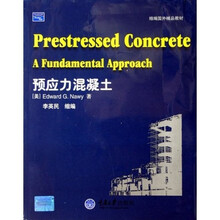预应力混凝土(国外精品教材缩编系列)

目 录内容简介
1 BASICCONCEPTS
1.1 Introduction
1.2 Historical Developmentof Prestressing
1.3 Basic Conceptsof Prestressing
1.4 Computationof Fiber Stressesina Prestressed Beamby The Basic Method
SELECTEDREFERENCES
PROBLEMS
2 MATERIALSANDSYSTEMSFORPRESTRESSING
2.1 Concrete
2.2 Stress-Strain Curveof Concrete
2.3 Modulusof Elasticityand Changein Compressive Strength With Time
2.4 Creep
2.5 Shrinkage
2.6 Nonprestressing Reinforcement
2.7 Prestressing Reinforcement
2.8 ACIMaximumPermissible Stressesin Concreteand Reinforcement
2.9 AASHTOMaximum Permissible Stressesin Concreteand Reinforcement
2.10 Prestressing Systemsand Anchorages
2.11 Circular Prestressing
2.12 TenPrinciples
SELECTEDREFERENCES
3 PARTIALLOSSOFPRESTRESS
3.1 Introduction
3.2 Elastic Shorteningof Concrete(ES)
3.3 Steel Stress Relaxation(R)
3.4 Creep Loss(CR)
3.5 Shrinkage Loss(SH)
3.6 Losses Dueto Friction(F)
3.7 Anchorage-Seating Losses(A)
3.8 Changeof Prestress Dueto Bendingofa Member(△fpB)
3.9 SIPrestress Loss Expressions
SELECTEDREFERENCES
PROBLEMS
4 FLEXURALDESIGNOFPRESTRESSEDCONCRETEELEMENTS
4.1 Introduction
4.2 Selectionof Geometrical Propertiesof Section Components
4.3 Proper Selectionof Beam Sectionsand Properties
4.4 End Blocksat Support Anchorage Zones
4.5 Flexural Designof CompositeBeams
4.6 Summaryof Step-by-StepTrial-and-Adjustment Procedure forthe Service-Load Designof Prestressed Members
4.7 Designof Composite Post-Tensioned Prestressed Simply Supported Section
4.8 Ultimate-Strength Flexural Design
4.9 Loadand Strength Factors
4.10 ACILoad Factorsand Safety Margins
4.11 Limit Statein Flexureat Ultimate Loadin Bonded Members:Decompressionto UltimateLoad
4.12 Preliminary Ultimate-Load Design
4.13 Summary Step-by-Step Procedurefor Limit.State-at-Failure Designofthe Prestressed Members
4.14 SIFlexural Design Expression
SELECTEDREFERENCES
PROBLEMS
5 SHEARANDTORSIONALSTRENGTHDESIGN
5.1 Introduction
5.2 Behaviorof Homogeneous BeamsinShear
5.3 BehaviorofConcreteBeamsas NonhomogeneousSections
5.4 Concrete Beams Without Diagonal Tension Reinforcement
5.5 Shearand Principal Stressesin Prestressed Beams
5.6 Web-Shear Reinforcement
5.7 Horizontal Shear Strengthin Composite Construction
5.8 Web Reinforcement Design Procedurefor Shear
5.9 Shear Strengthand Web-Shear Steel Designin aPrestressed Beam
5.10 Bracketsand Corbels
5.11 Torsional Behaviorand Strength
5.12 Torsionin Reinforcedand Prestressed Concrete Elements
5.13 Design Procedurefor Combined Torsionand Shear
5.14 Designof Web Reinforcementfor Combined Torsionand Shearin Prestressed Beams
5.15 Strut-and-Tie Model Analysisand Designof Concrete Elements
SELECTEDREFERENCES
PROBLEMS
6 INDETERMINATEPRESTRESSEDCONCRETESTRUCTURES
6.1 Introduction
6.2 Disadvantagesof Continuityin Prestressing
6.3 TendonLayout ForContinuous Beams
6.4 Elastic Analysis For Prestress Continuity
6.5 Examples Involving Continuity
6.6 Linear Transformationand Concordanceof Tendons
6.7 Ultimate Strengthand Limit Stateat Failureof Continuous Beams
6.8 Tendon Profile Envelopeand Modifications
6.9 Tendonand C-LineLocationin Continuous Beams
6.10 Indeterminate Framesand Portals
6.11 Limit Design(Analysis)ofI ndeterminate Beamsand Frames
SELECTEDREFERENCES
PROBLEMS
7 CAMBER,DEFLECTION,ANDCRACKCONTROL
7.1 Introduction
7.2 Basic Assumptionsin Deflection Calculations
7.3 Short-Term(Instantaneous)Deflectionof Uncrackedand Cracked Members
7.4 Short-Term Deflectionat Service Load
7.5 Short-Term Deflectionof Cracked Prestressed Beams
7.6 Long-Term Effectson Deflectionand Camber
7.7 PermissibleLimitsof Calculated Deflection
7.8 Cracking Behaviorand CrackControlin Prestressed Beams
7.9 CrackWidthand Spacing Evaluationin Pretensioned T-Beam Without Mild Steel
7.10 Crack Widthandspacing Evaluationfor Post-Tensioned T-Beam Containing Nonprestressed Steel
7.11 SIDeflectionand Cracking Expressions
SELECTEDREFERENCES
PROBLEMS
8 PRESTRESSEDCOMPRESSIONANDTENSIONMEMBERS
8.1 Introduction
8.2 Prestressed Compression Members:Load-MomentInteractionin ColumnsandPiles
8.3 Strength Reduction Factorφ
8.4 Operational Procedureforthe Designof Nonslender Prestressed Compression Members
8.5 Limit Stateat BucklingFailureof Slender(Long)Prestressed Columns
8.6 Moment Magnification Method:First-Order Analysis
8.7 Second-Order Frames Analysisandthe P-△Effects
8.8 Operational Procedureand Flowchartforthe Designof Slender Columns
8.9 Designof Slender(Long)Prestressed Column
8.10 Compression Membersin Biaxial Bending
8.11 Practical Design Considerations
8.12 Reciprocal Load Methodfor Biaxial Bending
8.13 Modified Load Contour Methodfor Biaxial Bending
8.14 Prestressed Tension Members
8.15 Suggested Step-by-Step Procedureforthe Designof Tension Members
8.16 Designof Linear Tension Members
SELECTEDREFERENCES
PROBLEMS
9 TWO-WAYPRESTRESSEDCONCRETEFLOORSYSTEMS
9.1 Introduction:Reviewof Methods
9.2 Flexural Behaviorof Two-Way Slabsand Plates
9.3 The Equivalent Frame Method
9.4 Two-Directional Load Balancing
9.5 Flexural Strengthof Prestressed Plates
9.6 Bandingof Prestressing Tendonsand Limiting Concrete Stresses
9.7 One-Way Slab Systems
9.8 Shear-Moment Transferto Columns Supporting Flat Plates
9.9 Step-by-StepTrial-and-Adjustment Procedureforthe Designofa Two-Way Prestressed Slaband Plate System
9.10 Designof Prestressed Post-Tensioned Flat-Plate FloorSystem
9.11 Direct Methodof Deflection Evaluation
9.12 Deflection Evaluationof Two-Way Prestressed Concrete FloorSlabs
9.13 Yield-Line Theory For Two-Way-Action Plates
9.14 Yield-Line Moment Strengthofa Two-Way Prestressed Concrete Plate
SELECTEDREFERENCES
PROBLEMS
10 CONNECTIONSFORPRESTRESSEDCONCRETEELEMENTS
10.1 Introduction
10.2 Tolerances
10.3 Reinforced Concrete Bearingin Composite Members
10.4 Dapped-End Beam Connections
10.5 Reinforced Concrete Bracketsand Corbels
10.6 Concrete Beam Ledges
10.7 Selected Connection Details
SELECTEDREFERENCES
PROBLEMS
APPENDIXAUNITCONVERSIONS
APPENDIXBSYMBOL
APPENDIXCABBREVIATION
1.1 Introduction
1.2 Historical Developmentof Prestressing
1.3 Basic Conceptsof Prestressing
1.4 Computationof Fiber Stressesina Prestressed Beamby The Basic Method
SELECTEDREFERENCES
PROBLEMS
2 MATERIALSANDSYSTEMSFORPRESTRESSING
2.1 Concrete
2.2 Stress-Strain Curveof Concrete
2.3 Modulusof Elasticityand Changein Compressive Strength With Time
2.4 Creep
2.5 Shrinkage
2.6 Nonprestressing Reinforcement
2.7 Prestressing Reinforcement
2.8 ACIMaximumPermissible Stressesin Concreteand Reinforcement
2.9 AASHTOMaximum Permissible Stressesin Concreteand Reinforcement
2.10 Prestressing Systemsand Anchorages
2.11 Circular Prestressing
2.12 TenPrinciples
SELECTEDREFERENCES
3 PARTIALLOSSOFPRESTRESS
3.1 Introduction
3.2 Elastic Shorteningof Concrete(ES)
3.3 Steel Stress Relaxation(R)
3.4 Creep Loss(CR)
3.5 Shrinkage Loss(SH)
3.6 Losses Dueto Friction(F)
3.7 Anchorage-Seating Losses(A)
3.8 Changeof Prestress Dueto Bendingofa Member(△fpB)
3.9 SIPrestress Loss Expressions
SELECTEDREFERENCES
PROBLEMS
4 FLEXURALDESIGNOFPRESTRESSEDCONCRETEELEMENTS
4.1 Introduction
4.2 Selectionof Geometrical Propertiesof Section Components
4.3 Proper Selectionof Beam Sectionsand Properties
4.4 End Blocksat Support Anchorage Zones
4.5 Flexural Designof CompositeBeams
4.6 Summaryof Step-by-StepTrial-and-Adjustment Procedure forthe Service-Load Designof Prestressed Members
4.7 Designof Composite Post-Tensioned Prestressed Simply Supported Section
4.8 Ultimate-Strength Flexural Design
4.9 Loadand Strength Factors
4.10 ACILoad Factorsand Safety Margins
4.11 Limit Statein Flexureat Ultimate Loadin Bonded Members:Decompressionto UltimateLoad
4.12 Preliminary Ultimate-Load Design
4.13 Summary Step-by-Step Procedurefor Limit.State-at-Failure Designofthe Prestressed Members
4.14 SIFlexural Design Expression
SELECTEDREFERENCES
PROBLEMS
5 SHEARANDTORSIONALSTRENGTHDESIGN
5.1 Introduction
5.2 Behaviorof Homogeneous BeamsinShear
5.3 BehaviorofConcreteBeamsas NonhomogeneousSections
5.4 Concrete Beams Without Diagonal Tension Reinforcement
5.5 Shearand Principal Stressesin Prestressed Beams
5.6 Web-Shear Reinforcement
5.7 Horizontal Shear Strengthin Composite Construction
5.8 Web Reinforcement Design Procedurefor Shear
5.9 Shear Strengthand Web-Shear Steel Designin aPrestressed Beam
5.10 Bracketsand Corbels
5.11 Torsional Behaviorand Strength
5.12 Torsionin Reinforcedand Prestressed Concrete Elements
5.13 Design Procedurefor Combined Torsionand Shear
5.14 Designof Web Reinforcementfor Combined Torsionand Shearin Prestressed Beams
5.15 Strut-and-Tie Model Analysisand Designof Concrete Elements
SELECTEDREFERENCES
PROBLEMS
6 INDETERMINATEPRESTRESSEDCONCRETESTRUCTURES
6.1 Introduction
6.2 Disadvantagesof Continuityin Prestressing
6.3 TendonLayout ForContinuous Beams
6.4 Elastic Analysis For Prestress Continuity
6.5 Examples Involving Continuity
6.6 Linear Transformationand Concordanceof Tendons
6.7 Ultimate Strengthand Limit Stateat Failureof Continuous Beams
6.8 Tendon Profile Envelopeand Modifications
6.9 Tendonand C-LineLocationin Continuous Beams
6.10 Indeterminate Framesand Portals
6.11 Limit Design(Analysis)ofI ndeterminate Beamsand Frames
SELECTEDREFERENCES
PROBLEMS
7 CAMBER,DEFLECTION,ANDCRACKCONTROL
7.1 Introduction
7.2 Basic Assumptionsin Deflection Calculations
7.3 Short-Term(Instantaneous)Deflectionof Uncrackedand Cracked Members
7.4 Short-Term Deflectionat Service Load
7.5 Short-Term Deflectionof Cracked Prestressed Beams
7.6 Long-Term Effectson Deflectionand Camber
7.7 PermissibleLimitsof Calculated Deflection
7.8 Cracking Behaviorand CrackControlin Prestressed Beams
7.9 CrackWidthand Spacing Evaluationin Pretensioned T-Beam Without Mild Steel
7.10 Crack Widthandspacing Evaluationfor Post-Tensioned T-Beam Containing Nonprestressed Steel
7.11 SIDeflectionand Cracking Expressions
SELECTEDREFERENCES
PROBLEMS
8 PRESTRESSEDCOMPRESSIONANDTENSIONMEMBERS
8.1 Introduction
8.2 Prestressed Compression Members:Load-MomentInteractionin ColumnsandPiles
8.3 Strength Reduction Factorφ
8.4 Operational Procedureforthe Designof Nonslender Prestressed Compression Members
8.5 Limit Stateat BucklingFailureof Slender(Long)Prestressed Columns
8.6 Moment Magnification Method:First-Order Analysis
8.7 Second-Order Frames Analysisandthe P-△Effects
8.8 Operational Procedureand Flowchartforthe Designof Slender Columns
8.9 Designof Slender(Long)Prestressed Column
8.10 Compression Membersin Biaxial Bending
8.11 Practical Design Considerations
8.12 Reciprocal Load Methodfor Biaxial Bending
8.13 Modified Load Contour Methodfor Biaxial Bending
8.14 Prestressed Tension Members
8.15 Suggested Step-by-Step Procedureforthe Designof Tension Members
8.16 Designof Linear Tension Members
SELECTEDREFERENCES
PROBLEMS
9 TWO-WAYPRESTRESSEDCONCRETEFLOORSYSTEMS
9.1 Introduction:Reviewof Methods
9.2 Flexural Behaviorof Two-Way Slabsand Plates
9.3 The Equivalent Frame Method
9.4 Two-Directional Load Balancing
9.5 Flexural Strengthof Prestressed Plates
9.6 Bandingof Prestressing Tendonsand Limiting Concrete Stresses
9.7 One-Way Slab Systems
9.8 Shear-Moment Transferto Columns Supporting Flat Plates
9.9 Step-by-StepTrial-and-Adjustment Procedureforthe Designofa Two-Way Prestressed Slaband Plate System
9.10 Designof Prestressed Post-Tensioned Flat-Plate FloorSystem
9.11 Direct Methodof Deflection Evaluation
9.12 Deflection Evaluationof Two-Way Prestressed Concrete FloorSlabs
9.13 Yield-Line Theory For Two-Way-Action Plates
9.14 Yield-Line Moment Strengthofa Two-Way Prestressed Concrete Plate
SELECTEDREFERENCES
PROBLEMS
10 CONNECTIONSFORPRESTRESSEDCONCRETEELEMENTS
10.1 Introduction
10.2 Tolerances
10.3 Reinforced Concrete Bearingin Composite Members
10.4 Dapped-End Beam Connections
10.5 Reinforced Concrete Bracketsand Corbels
10.6 Concrete Beam Ledges
10.7 Selected Connection Details
SELECTEDREFERENCES
PROBLEMS
APPENDIXAUNITCONVERSIONS
APPENDIXBSYMBOL
APPENDIXCABBREVIATION
目 录内容简介
《预应力混凝土》是根据培生教育出版集团出版的教材缩编而成的英文预应力混凝土教材。作者Edward G.Nawy是美国新泽西州州立大学土木与环境工程系教授,美国土木工程师学会和硕应力混凝土领域的专家。《预应力混凝土》作为该书最新修订的第5版,反映了2005年美国房屋标准ACI318-05和国际房屋标准 IBC2003的新要求,并以其独特的视角,系统地阐明了设计和分析预应力混凝土构件的方法和步骤,详细介绍了预应力混凝土的基本理论、设计方法及其在工程中的运用。
比价列表
公众号、微信群
 缺书网
缺书网微信公众号
 扫码进群
扫码进群实时获取购书优惠







